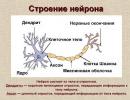Fluctuations. Harmonic vibrations. The equation of harmonic oscillations. Equation of harmonic oscillations Equation of damped oscillations
fluctuations called movements or processes that are characterized by a certain repetition in time. Oscillatory processes are widespread in nature and technology, for example, the swing of a clock pendulum, variable electricity etc. When the pendulum oscillates, the coordinate of its center of mass changes, in the case of alternating current, the voltage and current in the circuit fluctuate. The physical nature of oscillations can be different, therefore, mechanical, electromagnetic, etc. oscillations are distinguished. However, various oscillatory processes are described by the same characteristics and the same equations. From this comes the feasibility unified approach to the study of vibrations different physical nature.
The fluctuations are called free, if they are made only under the influence of internal forces acting between the elements of the system, after the system is taken out of equilibrium by external forces and left to itself. Free vibrations always damped oscillations because energy losses are inevitable in real systems. In the idealized case of a system without energy loss, free oscillations (continuing as long as desired) are called own.
The simplest type of free undamped oscillations are harmonic oscillations - fluctuations in which the fluctuating value changes with time according to the sine (cosine) law. Oscillations encountered in nature and technology often have a character close to harmonic.
Harmonic vibrations are described by an equation called the equation of harmonic vibrations:
Where A- amplitude of fluctuations, the maximum value of the fluctuating value X; - circular (cyclic) frequency of natural oscillations; - the initial phase of the oscillation at a moment of time t= 0; - the phase of the oscillation at the moment of time t. The phase of the oscillation determines the value of the oscillating quantity in this moment time. Since the cosine varies from +1 to -1, then X can take values from + A before - A.
Time T, for which the system completes one complete oscillation, is called period of oscillation. During T oscillation phase is incremented by 2 π , i.e.
Where . (14.2)
The reciprocal of the oscillation period
i.e., the number of complete oscillations per unit time is called the oscillation frequency. Comparing (14.2) and (14.3) we obtain
The unit of frequency is hertz (Hz): 1 Hz is the frequency at which one complete oscillation takes place in 1 s.
Systems in which free vibrations can occur are called oscillators . What properties must a system have in order for free oscillations to occur in it? The mechanical system must have position of stable equilibrium, upon exiting which appears restoring force towards equilibrium. This position corresponds, as is known, to the minimum of the potential energy of the system. Let us consider several oscillatory systems that satisfy the listed properties.
Changes in a quantity are described using the laws of sine or cosine, then such oscillations are called harmonic. Consider a circuit made of a capacitor (which was charged before being included in the circuit) and an inductor (Fig. 1).
Picture 1.
The harmonic oscillation equation can be written as follows:
$q=q_0cos((\omega )_0t+(\alpha )_0)$ (1)
where $t$-time; $q$ charge, $q_0$-- maximum charge deviation from its average (zero) value during changes; $(\omega )_0t+(\alpha )_0$- oscillation phase; $(\alpha )_0$ - initial phase; $(\omega )_0$ - cyclic frequency. During the period, the phase changes by $2\pi $.
Type equation:
the equation of harmonic oscillations in differential form for an oscillatory circuit that will not contain active resistance.
Any kind of periodic oscillations can be accurately represented as the sum of harmonic oscillations, the so-called harmonic series.
For the oscillation period of a circuit that consists of a coil and a capacitor, we get the Thomson formula:
If we differentiate expression (1) with respect to time, we can obtain the formula for the function $I(t)$:
The voltage across the capacitor can be found as:
From formulas (5) and (6) it follows that the current strength is ahead of the voltage on the capacitor by $\frac(\pi )(2).$
Harmonic oscillations can be represented both in the form of equations, functions as well as vector diagrams.
Equation (1) represents free undamped oscillations.
Damped oscillation equation
The change in charge ($q$) on the capacitor plates in the circuit, taking into account the resistance (Fig. 2), will be described differential equation type:

Figure 2.
If the resistance that is part of the circuit $R \
where $\omega =\sqrt(\frac(1)(LC)-\frac(R^2)(4L^2))$ is the cyclic oscillation frequency. $\beta =\frac(R)(2L)-$attenuation coefficient. The amplitude of damped oscillations is expressed as:
In the event that at $t=0$ the charge on the capacitor is equal to $q=q_0$, there is no current in the circuit, then for $A_0$ we can write:
The oscillation phase at the initial moment of time ($(\alpha )_0$) is equal to:
For $R >2\sqrt(\frac(L)(C))$ the change in charge is not an oscillation, the capacitor discharge is called aperiodic.
Example 1
Exercise: Maximum value charge is equal to $q_0=10\ C$. It changes harmonically with the period $T= 5 c$. Determine the maximum possible current.
Solution:
As a basis for problem solving we use:
To find the current strength, expression (1.1) must be differentiated with respect to time:
where the maximum (amplitude value) of the current strength is the expression:
From the conditions of the problem, we know the amplitude value of the charge ($q_0=10\ Kl$). You should find the natural frequency of oscillations. Let's express it as:
\[(\omega )_0=\frac(2\pi )(T)\left(1.4\right).\]
In this case, the desired value will be found using equations (1.3) and (1.2) as:
Since all quantities in the conditions of the problem are presented in the SI system, we will carry out the calculations:
Answer:$I_0=12.56\ A.$
Example 2
Exercise: What is the oscillation period in a circuit that contains an inductor $L=1$H and a capacitor if the current in the circuit changes according to the law: $I\left(t\right)=-0.1sin20\pi t\ \left(A \right)?$ What is the capacitance of the capacitor?
Solution:
From the equation of current oscillations, which is given in the conditions of the problem:
we see that $(\omega )_0=20\pi $, hence we can calculate the Period of the Oscillation using the formula:
\ \
According to Thomson's formula for a circuit that contains an inductor and a capacitor, we have:
Let's calculate the capacity:
Answer:$T=0.1$ c, $C=2.5\cdot (10)^(-4)F.$
For excitation in the oscillation circuit, the capacitor is preliminarily charged, giving its plates a charge ±q. Then at the initial time t= 0 (Fig. 19, A) an electric field will appear between the capacitor plates. If you close the capacitor to the inductor, the capacitor will begin to discharge, and a current increasing with time will flow in the circuit I. When the capacitor is fully discharged, the energy of the electric field of the capacitor is completely converted into energy magnetic field coils (Fig. 19, b). Starting from this moment, the current in the circuit will decrease, and, consequently, the magnetic field of the coil will begin to weaken, then, according to Faraday's law, a current is induced in it, which flows in accordance with the Lenz rule in the same direction as the capacitor discharge current. The capacitor will start to recharge, an electric field will appear, tending to weaken the current, which, in the end, will turn to zero, and the charge on the capacitor plates will reach a maximum (Fig. 19, V). Further, the same processes will begin to proceed in the opposite direction (Fig. 19, G), and the system by the time t=T (T- oscillation period) will return to its original state (Fig. 19, A). After that, the repetition of the considered cycle of discharging and charging the capacitor will begin, that is, periodic undamped oscillations of the charge value will begin. q on the capacitor plates, voltage U C on the capacitor and current I flowing through the inductor. According to Faraday's law, the voltage U C on the capacitor is determined by the rate of change of the current strength in the inductor of an ideal circuit, that is:
Based on the fact that U C \u003d q / C, A I=dq/dt, we get differential equation of free undamped harmonic oscillations charge magnitude q on the capacitor plates:
 or
or  .
.
The solution to this differential equation is a function q(t), that is equation of free undamped harmonic oscillations charge magnitude q on the capacitor plates:
Where q(tt;
q 0 is the amplitude of charge oscillations on the capacitor plates;
- circular (or cyclic) oscillation frequency () ;
2 /T(T is the oscillation period, ![]() –Thomson's formula);
–Thomson's formula);
is the phase of the oscillations at the moment of time t;
- the initial phase of oscillations, that is, the phase of oscillations at the time t=0.
Equation of free damped harmonic oscillations. In a real oscillatory circuit, it is taken into account that, in addition to the coil, the inductance L capacitor WITH, the circuit also has a resistor with a resistance R, which is different from zero, which is the reason for the damping of oscillations in a real oscillatory circuit. Free damped oscillations– oscillations, the amplitude of which, due to energy losses by a real oscillatory system, decreases over time.
For a circuit of a real oscillatory voltage circuit on a series-connected capacitor with a capacitance WITH and a resistor R add up. Then, taking into account the Faraday law for the circuit of a real oscillatory circuit, we can write:
 ,
,
where is the electromotive force of self-induction in the coil;
U C is the voltage across the capacitor ( U C \u003d q / C);
IR is the voltage across the resistor.
Based on the fact that I=dq/dt, we get differential equation of free damped harmonic oscillations charge magnitude q on the capacitor plates:
 or
or  ,
,
where is the oscillation damping coefficient () , .
q(t), that is equation of free damped harmonic oscillations charge magnitude q on the capacitor plates:
Where q(t) - the amount of charge on the capacitor plates at the time t;
is the amplitude of damped charge oscillations at the moment of time t;
q 0 is the initial amplitude of damped charge oscillations;
is the circular (or cyclic) oscillation frequency (  );
);
is the phase of damped oscillations at the moment of time t;
is the initial phase of damped oscillations.
The period of free damped oscillations in a real oscillatory circuit:
 .
.
Forced electromagnetic oscillations. In order to obtain undamped oscillations in a real oscillatory system, it is necessary to compensate for energy losses in the process of oscillations. Such compensation in a real oscillatory circuit is possible with the help of an external alternating voltage periodically changing according to the harmonic law U(t):
![]() .
.
In this case differential equation of forced electromagnetic oscillations will take the form:
 or
or  .
.
The solution of the resulting differential equation is the function q(t):
In the steady state, forced oscillations occur with a frequency w and are harmonic, and the amplitude and phase of oscillations are determined by the following expressions:
 ;
;  .
.
It follows that the amplitude of charge oscillations has a maximum at the resonant frequency of the external source:
![]() .
.
The phenomenon of a sharp increase in the amplitude of forced oscillations when the frequency of the driving alternating voltage approaches a frequency close to the frequency is called resonance.
Topic 10. Electromagnetic waves
According to Maxwell's theory, electromagnetic fields can exist in the form of electromagnetic waves, the phase velocity distribution of which is determined by the expression:
 ,
,
where and are the electric and magnetic constants, respectively,
e And m are the electrical and magnetic permeability of the medium, respectively,
With- the speed of light in vacuum () .
In a vacuum ( e= 1, m= l) the propagation speed of electromagnetic waves coincides with the speed of light ( With), which is consistent with Maxwell's theory that
that light is an electromagnetic wave.
According to Maxwell's theory electromagnetic waves are transverse, that is, the vectors and strengths of the electric and magnetic fields are mutually perpendicular and lie in a plane perpendicular to the vector
wave propagation speed, and the vectors , and form a right screw system (Fig. 20).

It also follows from Maxwell's theory that in an electromagnetic wave the vectors and oscillate in the same phases (Fig. 20), that is, the values of the intensities E And H electric and magnetic fields simultaneously reach a maximum and simultaneously vanish, and the instantaneous values E And H related by the ratio: ![]() .
.
Planar Monochromatic Equation electromagnetic wave (indices at And z at E And H emphasize only that the vectors and are directed along mutually perpendicular axes in accordance with Fig. 20).






